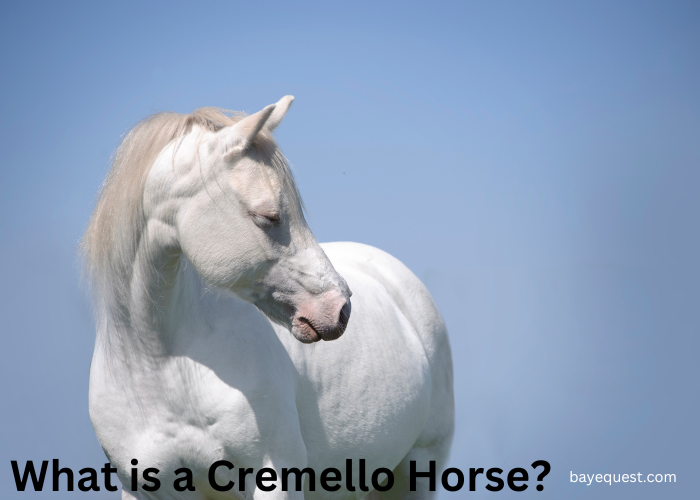A Cremello horse is hard to miss. With its striking cream-colored coat and bright blue eyes, it has a beauty all its own.
This horse isn’t just about looks, though. Its unique color comes from a special genetic makeup that sets it apart from other horses.
Many people mistake a Cremello for other light-colored horses, but there’s more to its story.
Let’s dive into what makes this horse stand out and why it’s so rare in the horse world.
What is a Cremello Horse? Key Takeaway
A Cremello horse is a horse with a cream-colored coat, pink skin, and blue eyes caused by a double cream dilution gene. This gene lightens the horse’s chestnut base color, resulting in its pale appearance. Cremellos can be found in various breeds, making them rare and unique.
Origin and History of the Cremello Horse
The origin of the Cremello horse isn’t tied to a specific breed or location, but rather to its genetics.
The Cremello color comes from a double dose of the cream dilution gene, which affects the horse’s base coat color.
This gene can appear in various breeds, so Cremellos aren’t exclusive to one group.
Historically, horses with cream coats have been admired for their rarity and beauty, often used in royal ceremonies and art.
Cremello horses likely trace their lineage to regions where light-colored horses were selectively bred.
Over time, breeders began to understand the genetics behind this striking coat color, and the desire for these beautiful horses grew.
Today, you can find Cremello horses in many breeds, but they remain uncommon due to the specific genetics required to produce the color.
Their rarity adds to their appeal, making them a prized addition in certain breeding programs.
Characteristics of the Cremello Horse
Some characteristics of the Cremello horse are:
Cream-colored coat
Cremellos have pale, cream-colored coats, which can sometimes appear almost white in sunlight.
This distinct coloring is due to a double dilution of the base color gene, usually chestnut, giving the horse its strikingly light appearance.
Bright blue eyes
One of the most remarkable features of a Cremello horse is its piercing blue eyes.
Unlike the dark eyes of most horses, the blue eyes of a Cremello are a result of the same gene that causes the light coat.
This feature makes them stand out even more, giving them a unique, captivating look.
Interesting read: Horses with Blue Eyes.
Pink skin
Cremellos have light pink skin beneath their cream-colored coats. This is another trait caused by the dilution gene.
The pink skin is more prone to sunburn, which means these horses need extra protection from the sun.
Double cream gene
The Cremello color comes from having two copies of the cream dilution gene.
This genetic combination takes a chestnut base coat and dilutes it to a very light cream.
It’s this double gene that sets Cremellos apart from other cream-colored horses, like the Palomino, which only has one cream gene.
Silky coat texture
The coat of a Cremello horse is often soft and silky to the touch.
This smooth texture adds to their overall elegant appearance. Their coats may look especially glossy in the sunlight, enhancing their beauty.
Distinctive appearance
With their light-colored coat, pink skin, and bright blue eyes, Cremellos have a distinctive, almost ethereal look.
They are often mistaken for albinos, but they are not. Their coloring comes from the cream gene, not a lack of pigmentation.
Friendly and calm temperament
Although temperament can vary depending on the breed, Cremellos are often described as calm, gentle, and friendly.
Many owners find them easy to handle and pleasant to work with, making them suitable for riders of all levels.
Gentle and friendly temperament
Cremello horses are often calm and gentle.
They have a friendly, approachable temperament, which makes them great companions for beginners and experienced riders.
While temperament depends on the breed, Cremellos are often described as patient and easy-going.
This makes them well-suited for various equestrian activities, from pleasure riding to competitive events.
Adaptable and trainable
Cremellos are usually adaptable to different environments and training methods.
Their calm disposition allows them to handle new experiences without becoming overly stressed or reactive.
This makes them easier to train compared to more high-strung horses.
Science Behind Cremello Coloration
The Cremello horse’s unique coloration comes from its genetics, specifically the cream dilution gene.
This gene has the power to lighten the horse’s coat, skin, and eyes.
Cremellos carry two copies of this gene, which means both parents passed it down.
This double dose of the cream gene drastically lightens the horse’s base color, creating their signature cream coat.
The base coat of a Cremello horse is usually chestnut. However, the double cream gene dilutes this chestnut color into a pale, almost white, cream.
Without the cream gene, these horses would have a much darker appearance.
In addition to their light coat, Cremellos have pink skin.
This happens because the cream gene reduces the amount of dark pigment in the skin.
The pink color is most noticeable on areas like their muzzle and around their eyes.
Cremellos also have striking blue eyes, which are a result of the cream gene affecting eye pigmentation.
Though Cremellos may look like albino horses, they aren’t. Albinism is the total absence of pigment, while Cremellos have diluted pigmentation.
Their appearance is due to the specific effect of the cream gene on their chestnut base color, not a complete lack of pigment.
| Gene Type | Effect | Appearance |
| Base coat color | Chestnut (without dilution) | Reddish-brown coat with dark eyes |
| Cream gene | Single cream gene dilutes chestnut to palomino or similar color | Light golden or palomino coat, may have lighter eyes |
| Double cream gene | Double cream gene dilutes chestnut to cream (Cremello) | Cream-colored coat with pink skin and blue eyes |
The Role of Melanin in Cremello Coloration
Melanin plays a crucial role in determining the coloration of horses, including Cremello horses. Here’s how it works:
Melanin is the pigment responsible for the color of a horse’s skin, hair, and eyes.
In most horses, melanin levels determine whether they have darker colors like black or chestnut.
However, in Cremello horses, the double cream dilution gene reduces the production of melanin.
This reduction is what gives Cremellos their signature light cream coat, pink skin, and blue eyes.
The cream gene doesn’t remove melanin entirely but dilutes it, affecting both the skin and hair color.
The blue eyes also result from reduced melanin in the iris, giving them their bright, striking appearance.
What are Cremello Horses Used for?
Cremello horses are versatile and can be used for a wide range of activities, just like other horses. Here are some common uses:
1. Riding and pleasure activities
Cremellos are often used for general riding and pleasure activities.
Their calm temperament and striking appearance make them popular for recreational riding.
Riders who want a visually unique horse often seek out Cremellos for this purpose.
2. Show horses
Due to their distinctive cream coat and blue eyes, Cremello horses stand out in the show ring.
They are frequently entered in beauty and performance competitions, where their appearance draws attention.
Depending on their breed, they can compete in disciplines like dressage, show jumping, and Western riding.
3. Breeding programs
Cremellos are highly valued in breeding programs, particularly for producing certain coat colors.
When bred with non-diluted horses, they can pass on the cream gene to their offspring to produce Palomino or Buckskin horses.
This makes them valuable to breeders looking to create horses with specific color traits.
4. Equestrian sports
Like other horses, Cremellos can participate in a variety of equestrian sports.
Depending on their breed and training, they can be used in disciplines like dressage, barrel racing, or eventing.
Their versatility in different sports makes them sought-after for a variety of activities.
5. Ceremonial and exhibition horses
Cremello horses’ elegant appearance makes them suitable for use in parades, exhibitions, and ceremonial events.
Their light coat and striking eyes create a dramatic visual effect, making them perfect for aesthetic settings.
Is Cremello a Breed or a Color?
Cremello is not a breed; it is a color. The term “Cremello” refers to a horse’s coat color.
It results from specific genetic factors, particularly the presence of two copies of the cream dilution gene.
This genetic combination lightens the horse’s base coat color, usually chestnut, to a pale cream shade.
Cremello horses can be found in various breeds, as the color is not tied to a particular breed but to the genetic makeup.
Breeds Commonly Associated With the Cremello Horse
Cremello horses can be found in several different breeds. Here are some breeds commonly associated with the Cremello color:
American Quarter Horse
The American Quarter Horse can carry the cream dilution gene, which produces Cremellos.
Quarter Horses are highly versatile, excelling in disciplines like racing, western pleasure, and reining.
American Saddlebred
Known for their elegance and smooth gaits, American Saddlebreds can also display the Cremello coloration.
This breed is often used in show rings for saddleseat riding, and their striking Cremello color can be a real standout in competitions.
Thoroughbred
Though less common, some Thoroughbreds can be Cremello.
These horses are bred for racing, but some breeders seek out Cremellos for their striking appearance and potential in breeding programs.
Tennessee Walking Horse
Famous for their smooth, comfortable gaits, Tennessee Walking Horses can be found in the Cremello color.
These horses are commonly used for pleasure riding and in show rings where their unique color is admired.
Percheron
Though known for being draft horses with dark coats, Percherons can sometimes carry the cream gene.
A Cremello Percheron is quite rare but can be found in certain breeding programs.
Morgan Horse
The Morgan horse is a versatile breed known for its strength, beauty, and good temperament.
Morgans can also carry the cream gene, leading to the occasional Cremello in this breed.
Gypsy Vanner
This breed with a striking appearance and long, flowing mane and tail, can also display the Cremello color.
Gypsy Vanners are often used in shows and parades, where their stunning looks make them highly desirable.
Welsh Pony
Smaller horse breeds, such as the Welsh Pony, can also carry the double cream gene.
A Cremello Welsh Pony may be found in breeding programs where lighter colors are preferred for show ponies.
How to Care for a Cremello Horse
Caring for a Cremello horse requires some special attention, especially because of their light coat, pink skin, and blue eyes.
Here’s how to provide the best care:
Sun protection
Cremello horses have pink skin, making them more prone to sunburn.
Provide shade, use horse-safe sunblock, and consider using UV-protective fly masks.
Coat care
Their light coat shows dirt easily, so regular grooming and occasional baths are essential.
Use whitening shampoos to help maintain the brightness of their cream-colored coat.
Eye care
Their blue eyes are sensitive to bright sunlight, so use a fly mask with UV protection.
Regularly check for signs of irritation or watering and consult a vet if necessary.
Diet and nutrition
Feed Cremellos a balanced diet with quality hay or pasture to support overall health.
Supplements like omega-3 or biotin can help maintain their coat’s shine and skin health.
Skin and health monitoring
Pink skin is sensitive, so regular checks for irritation or infections are important.
Use fly repellents and fly sheets to protect them from insect bites.
Hoof care
Cremellos need regular hoof trimming by a farrier to keep their feet in good condition.
Clean their hooves regularly to prevent infections like thrush.
Exercise and mental stimulation
Daily exercise helps maintain their physical health, whether through riding or turnout.
Mental activities like trail riding or groundwork can prevent boredom.
Veterinary care
Routine vet checkups ensure they stay healthy, with attention to vaccinations and deworming.
How Much Do Cremello Horses Cost?
The cost of a Cremello horse can vary depending on several factors, including its breed, age, training, and pedigree.
On average, Cremello horses can range from $3,000 to $10,000. However, prices can be higher for well-bred or professionally trained horses.
For rare or high-demand breeds, the price may go beyond $15,000.
This is especially true if the horse has excellent lineage or proven performance in competitions.
The Cremello Horse in Popular Culture
Cremello horses are popular in movies, TV shows, and advertisements because of their striking appearance.
Their cream-colored coats and blue eyes make them stand out on screen.
They are often used in fantasy films or historical dramas as royal horses or mythical creatures.
The unique color of a Cremello gives them a magical or majestic look, perfect for dramatic scenes.
In advertising, Cremellos are chosen for their rare horse color beauty, catching the viewer’s attention instantly.
Although not the most famous in popular culture, their memorable appearance leaves a lasting impression.
Difference Between Cremello, Perlino, and Palomino
Cremello, Perlino, and Palomino horses are all beautiful and unique, but their differences come down to color genetics and appearance.
Cremello horses have a light cream coat, pink skin, and striking blue eyes.
Their color comes from having two copies of the cream dilution gene on a chestnut base coat, which lightens the coat to an almost white appearance.
Their pale look and bright eyes make them stand out, and their color is often described as ethereal.
Perlino horses also have two copies of the cream gene, but on a bay base coat.
This gives them a light cream body similar to the Cremello, but with a noticeable reddish or copper tint to their mane and tail.
Their pink skin and blue or amber eyes are also common traits.
Perlino horses look slightly warmer in tone compared to Cremellos because of the underlying bay color.
Palomino horses are different because they have only one copy of the cream dilution gene on a chestnut base coat.
This gives them a rich golden color with a white or light-colored mane and tail.
Palominos have dark skin and brown or amber eyes, setting them apart from Cremellos and Perlinos, which have lighter skin and eyes.
The Palomino’s striking golden coat is highly sought after and often seen in show rings.
Myths and Misconceptions Surrounding Cremello
1. Myth. Cremello horses are albino.
Fact. Cremellos are not albino; they have a cream dilution gene that lightens their coat, but they still have pigmentation.
2. Myth. Cremellos are blind or have poor vision because of their blue eyes.
Fact. Cremellos have normal vision, and their blue eyes are simply a result of genetics.
3. Myth. Cremello horses are more delicate or weaker than other horses.
Fact. While they are more prone to sunburn, Cremellos are just as strong and healthy as other horses with proper care.
4. Myth. Cremello is a breed.
Fact. Cremello refers to a coat color, not a specific breed, and can appear in various horse breeds.
5. Myth. Cremellos are rare because they are difficult to breed.
Fact. Cremellos can be produced reliably with specific genetic pairings, but their rarity is due to their unique color, not breeding difficulty.
Do Cremello Horses Sunburn?
Yes, Cremello horses are more prone to sunburn than darker-coated horses.
This is because they have pink skin under their light cream-colored coat.
This skin lacks the dark pigmentation that provides protection from the sun.
Areas with less hair, like their nose, around the eyes, and ears, are especially vulnerable to sunburn.
To prevent sunburn, provide shade, apply horse-safe sunblock to sensitive areas, and consider using UV-protective fly masks.
Read also: What is a Gaited Horse Breed?
Conclusion
The Cremello horse is a true standout with its cream-colored coat, pink skin, and striking blue eyes.
It’s not just their beauty that makes them special, but also their unique genetics and gentle temperament.
Whether you’re looking for a stunning show horse, a calm riding companion, or a valuable addition to a breeding program, Cremellos offer something truly rare.
They may require a little extra care, but their beauty and charm are well worth it.
A Cremello is more than a horse—it’s a piece of living art.








